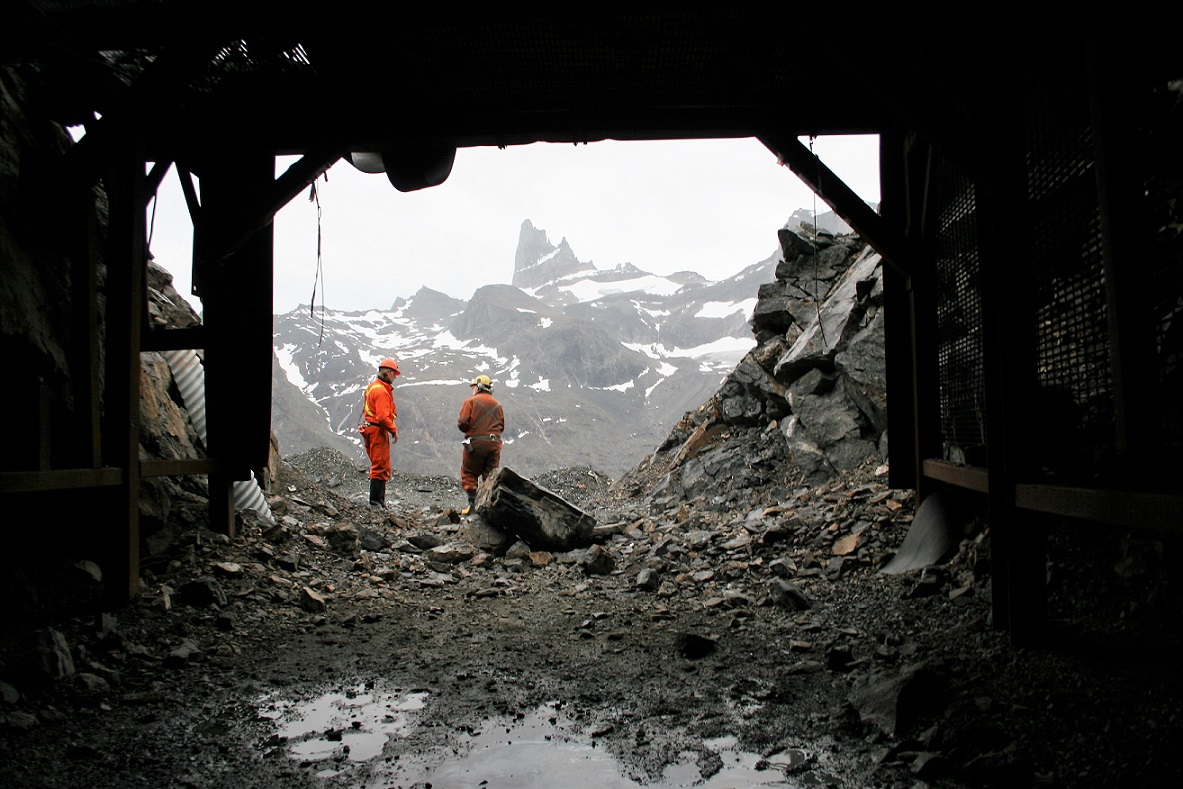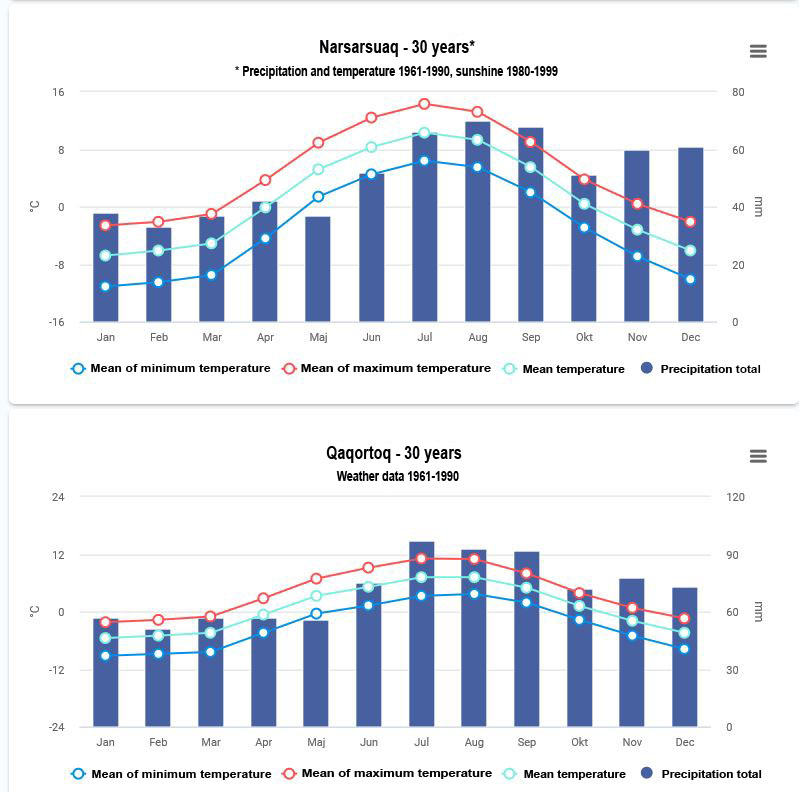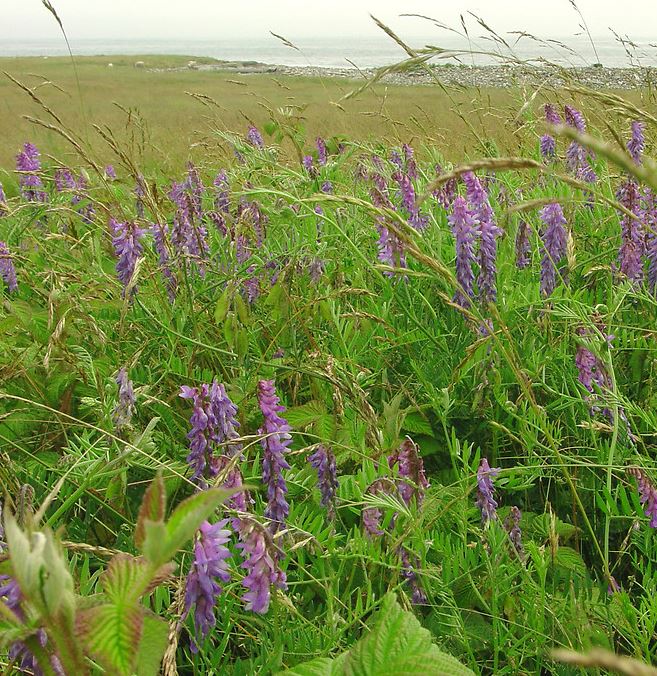Environment
Geology
Greenland was created by periods with continental shifts, volcanos, earthquakes and ice ages.
The plate tectonic of today means that Greenland is moving an inch away from Europe, each year.
Greenland’s underground consists of folded gneiss created 1600 million years ago. 500 million years ago, the continents clashed and moved away from each other again 65 million years ago. This created a lot of volcanic activity, which again created many new mountains. Several ice ages, since that, have again changed the landscape.
Greenland can be divided in 5 or 6 geological blocks. The Ketilidic fold is at the southern tip of Greenland and goes up to the Archaic block northwest of it.
Greenland has most of the time been covered by enormous layers of ice. The last ice age stopped 12000 years ago and has formed the land with U-shaped fiords and valleys. The ground rock has been grinded flat; the cold climate has given only sparse vegetation and has prevented the weathering of the rock.
Of the known 3500 minerals, 500 can be found in Greenland. Since 2009 Greenland has worked on getting commercial exploitation of these started. The most interesting are currently Rubies, Zink, Uranium, and Gold and rare earth minerals.

Nalunaq gold mine, photo Ole Christiansen
Geography
Greenland is situated between Canada, the Polar Sea, Iceland and the North Atlantic Ocean.
The wast ice desert covering 85 % of the land has approximately 9 % of the planet’s fresh water captured in an ice fist; it has an enormous effect on the climate and weather conditions.
4500 years ago, the first people came to Greenland. The country has been populated on and off since then. The oldest peoples are called paleo escimos; Independence Inuit I, Saqqaq Inuit, Independence Inuit II, Dorset I and II; then came the Norse around year 1000 and after them the neo escimo Inuit called Thule Inuit, who stayed and today inhabit the world’s largest island.
In 1721, Hans Egede from Denmark/Norway came and colonized Greenland. He came to find the rest of the Norse and convert them from Catholics to Protestants. He did not find any Norse, but Christianized the Thule Inuit instead.
In 1933, after Norway claimed the Northeastern Greenland, the International Court in Hague, decided that all of Greenland should be Danish.
In 1953, the Danish people decided that Faroe Islands and Greenland should become equal parts of the Danish kingdom.
Greenland got home rule in 1979 and in 2009, it got self-government. The majority of the Greenlandic people want independence, but they do not all agree on when this should be.
The climate of South Greenland
Southwest Greenland has a sub to low Arctic climate, yet lies at the same latitude as southern Norway, with its temperate coastal climate warmed by the Gulf Stream. By contrast, Baffin Island in Eastern Canada, which is also located at the same latitude, has a cooler and more continentally influenced low Arctic climate. Southwest Greenland is thus a transitional region, with continental, oceanic and Alpine climatic factors, from the Gulf Stream warmed waters of the North Atlantic to the climate of northeastern Canada.
Greenland extends from lat. 59° 47' N to 83° 40' N, and offers considerable climatic variation from north to south. The country is divided into a high Arctic climate zone in northern Greenland, a low Arctic area in the largest remaining portion of Greenland, and a subarctic zone in the inner fjord areas of Southwest Greenland.
The high and low Arctic is the proper Arctic, whereas the subarctic is a transitional zone, featuring the tundra woodland that is typically found between the temperate boreal climate zone and the Arctic.
Here we will only deal with the sub and low Arctic, which is of importance for agriculture. The basis for reindeer and sheep farming is thus the relatively mild climatic conditions in the southernmost part of Greenland, with a low Arctic climate zone in coastal areas and a subarctic climatic zone (the border region between the temperate and Arctic areas) in the inner fjords. The border between low and subarctic often lies very close to an isotherm that links localities with approx. 10°C as the mean temperature in July. If we apply this rule of thumb to Greenland, then areas with approx. 10°C in July would be subarctic (or, perhaps more accurately, boreal), implying that low-lying land in the inner fjord areas of South Greenland should be classified as Arctic.
Botanist Jon Feilberg, however, divides the areas south of 63° latitude into climatic zones based on flora geography and the presence of willow and birch thickets:
1. The outermost zone near the sea (hyper-oceanic, low Arctic): no thickets
2. The outermost fjord areas (oceanic, low Arctic): willow thickets
3. Intermediate fjord (sub-oceanic, sub-/low Arctic): birch and willow thickets
Annual precipitation of approx. 600 to 800 mm; approx. 7 months,
mean temperature above freezing. Birch thicket woodlands
(inner fjord areas, Cape Farewell-Arsuk)
This last area is by far the most important zone for agriculture!
Summer temperatures vary to a fair degree in Southwest Greenland. There is a relatively large difference between stations located inland (Narsarsuaq) and coastal areas, including the outer fjord areas (Upernaviarsuk/Nanortalik/Alluitsup Paa). Winter temperatures drop to approx. -7°C during the coldest months in the inner fjord areas.
The outer fjord areas have a warmer winter climate with lows of approx. 5°-6°C. Summer temperatures in the warmest month reach approx.
7°-8°C in the outer fjord areas of South Greenland (Upernaviarsuk),
rising toward the end of the fjords to 10°-11°C (Narsarsuaq).
During normal years, grazing areas enjoy growth periods with average temperatures of 5°C from late May/early June to mid/late September, with a longer growing season in the inner fjords in comparison to the outer areas. For further information on climatic norms in Qaqortoq and Nanortalik, please see http://dmi.dk

Soil types in South Greenland
The sub and low Arctic soil in South Greenland is characterized by a lack of nutrients. The amount of available nutrients is determined by the relationship between their total amount in the soil, the rate at which they are broken down, and immobilizations. The mountains in South Greenland consist primarily of acidic rocks such as granite, gneiss and sandstone. Soils that develop from these rocks are acidic and low in nutrients. There is also basalt, and the pH neutral soils that form from these rocks are rich in nutrients. The region is generally characterized by a slightly podsol type of soil with a low pH and small amounts of accessible plant nutrients. Larger concentrations of clay occur rarely, but considerable quantities of silt are often observable on the surface. There also occurs a certain amount of brown earth in inland areas.
Decomposition takes place slowly due to the low summer temperatures and predominantly acidic soil conditions. Soil analyses reveal low reaction numbers and low concentrations of phosphorus and potassium. The inner fjord areas generally have higher reaction numbers than the outer fjord areas, based in part on the lower amount of precipitation in inland areas and the addition of mineral soil in the form of loess ("glacial flour"). A limited amount of erosion occurs at some locations, particularly in areas near the edge of the ice cap.
Many types of soil have a limited capacity to absorb water, and occasionally there is a lack of precipitation, particularly in the inner fjord areas. Droughts occur during the summer, causing low course fodder yields and economic difficulties. Permafrost, which is defined as soil that is at or below the freezing point of water (0°C) for at least two years, is found sporadically in the lowlands of Southwest Greenland.
Vegetation
After last ice age 8-12,000 years ago, the vegetation started from scratch.
In 1911, botanists found categorized 310 species of plants, including 15 new species.
The land is covered with mosses and low-lying shrubs (dwarf willow and crowberry).
Plant life in South is more abundant than in North, and willows and dwarf birch can grow several feet tall.
Horti culture is very much used in South Greenland; the most successful vegetables are Potato, turnip, radish, lettuce, parsley and rhubarb. Many gardens have ornamental plants and imported tree species.
Norse and modern agriculture have many similarities. The Norse, like many modern farmers, grew grass for winter fodder and besides they had vegetables. Pollen analysis show that the Norse among other domesticated plants grew barley.
 - lille.JPG?ver=2020-02-17-192223-577)
Component area 4, Southbound hillside near the sheep farm of Timerliit, photo Arnaq Bjerge
Animal life
The richness in the Arctic is in the sea. The Inuit lived by the sea and from the sea, giving them very good living conditions. A majority of the ruins of Inuit winter settlements found all over the Arctic are concentrated around polynyas (all winter open water areas in the winter ice). Here they could hunt the animals that overwinter, trapped in the sparse open water areas.
In summer, many sea mammals and birds migrate to the Arctic to forage and eat.
The sea mammals are ringed seal, harbour seal, harp seal, hooded seal, bearded seal and walrus. The smaller whales are porpoises, dolphins, pilot whales, beluga and Narwhale. Bigger whales like Minke whales, bowhead whale, hump back whales.
The sea birds are Rissa, great black-backed gull, little auk, black guillemot, auk, guillemot, ducks and eider duck.
The sea mammals are ringed seal, harbour seal, harp seal, hooded seal, bearded seal and walrus.
The smaller whales are porpoises, dolphins, pilot whales, beluga and Narwhale.
Bigger whales are Minke whale, bowhead whale and hump back whales.
The sea birds are Rissa, great black-backed gull, little auk, black guillemot, auk, guillemot, ducks and eider duck,
The most common fish are sculpin, fiord cod/ogac, cod, Arctic char, salmon, halibut, Greenland halibut and capelin.
On land, they could hunt the large musk ox, caribou, foxes, hares, and rock ptarmigan.
Animals and plants in the World Heritage Area
South Greenland has a rich and varied animal life both at sea and on land.
In the Arctic you find the richness and the fertility in the sea. The Inuit culture has always lived by the sea, on the sea and from the sea. As fertile as it is, just as vulnerable it is to overuse and pollution.
Every spring/summer many fishes, birds and mammals migrate to Greenland to eat – whales, seals and migrating birds.
The Greenland vegetation consits of more than 500 taller plants, that is flowers, ferns etc. The lichens (tough plants on stones and sandy soil) are the largest group of plants – around 950 species; 600-700 different taller fungi; a bit fewer mosses and firm algae.
Most of the taller plants are wide spread in the arctic and alpine areas. Only a few are endemic plants (only found here in isolated environments). A few have been imported by the Norse, e.g. Cow Vetch (Vicia cracca).

Cow Vetch (Vicia cracca)
We encourage not to disturb animal life and vegetation unnecessarily. Locals and visitors to Greenland will enjoy seeing these – also when you are not visiting anymore.